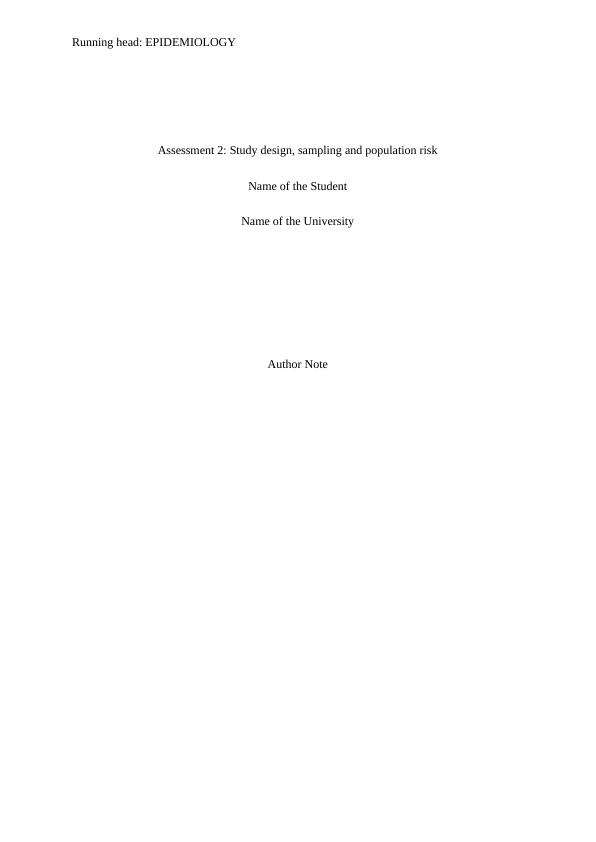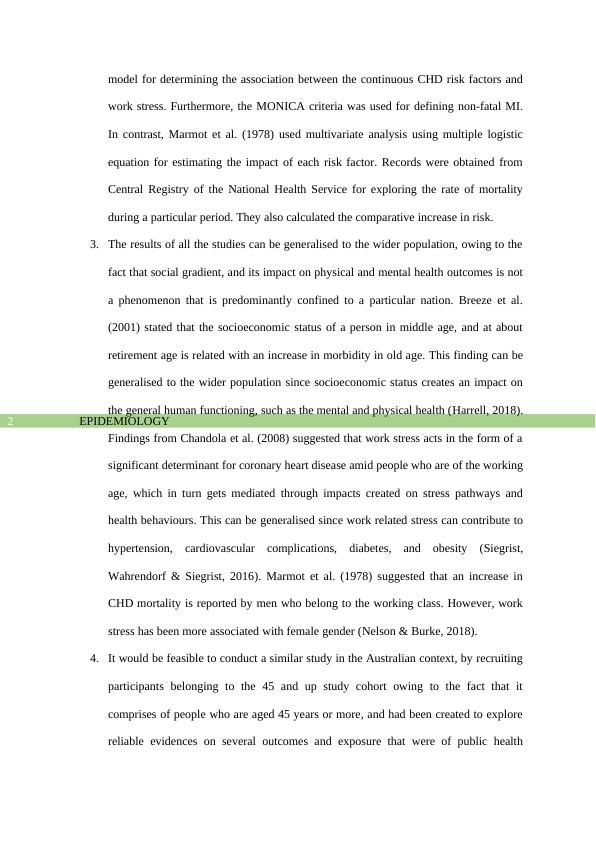Study Design, Sampling and Population Risk in Epidemiology
Added on 2022-11-13
7 Pages1920 Words141 Views
Running head: EPIDEMIOLOGY
Assessment 2: Study design, sampling and population risk
Name of the Student
Name of the University
Author Note
Assessment 2: Study design, sampling and population risk
Name of the Student
Name of the University
Author Note

EPIDEMIOLOGY1
Part 1
1. The sampling frame used for the first Whitehall I study involved male British civil
servants in order to determine the risk factors for cardiorespiratory disease. This
initial prospective cohort study was conducted in order to examine more than 17,500
men civil servants who were aged between 20 and 64, and the research was conducted
over a timespan of ten years, commencing from 1967. This study was based on
drawing a comparison regarding mortality of individuals who were employed in the
civil services and also demonstrated that the rate of mortality was higher amid low
grade servants, in comparison to high grade servants. In contrast, the second cohort
study was the Whitehall II study was conducted between 1985 and 1988, with the aim
of exploring the health status of 10,308 civil servants, who were aged 35-55 years. Of
them one third were females and two third were males (Marmot et al., 1991). This
study investigated the association between stress, work and health of the servants.
2. Breeze et al. (2001) used four different measures for determining morbidity risks of
the participants namely, general poor health, poor physical performance, poor mental
health, and disability. The researchers also used the Short Form 36 Health Survey
(SF-36) to measure the health status of the patients, in addition to classifying the
participants based on their employment grade. Statistical analysis was conducted by
chi-square tests that helped in determining univariate association. The researchers also
performed Logistic regression (Stata5 for Windows 3.1) for estimating the odds ratio
and confidence interval for each outcome. Data collection by Chandola et al. (2008)
encompassed measuring the self-reported work stress with the use of the job-strain
questionnaire. The researchers used cox proportional hazard regression models for
exploring the association between CHD event incident and work stress measures,
following adjustment for different variables. They also used linear/logistic regression
Part 1
1. The sampling frame used for the first Whitehall I study involved male British civil
servants in order to determine the risk factors for cardiorespiratory disease. This
initial prospective cohort study was conducted in order to examine more than 17,500
men civil servants who were aged between 20 and 64, and the research was conducted
over a timespan of ten years, commencing from 1967. This study was based on
drawing a comparison regarding mortality of individuals who were employed in the
civil services and also demonstrated that the rate of mortality was higher amid low
grade servants, in comparison to high grade servants. In contrast, the second cohort
study was the Whitehall II study was conducted between 1985 and 1988, with the aim
of exploring the health status of 10,308 civil servants, who were aged 35-55 years. Of
them one third were females and two third were males (Marmot et al., 1991). This
study investigated the association between stress, work and health of the servants.
2. Breeze et al. (2001) used four different measures for determining morbidity risks of
the participants namely, general poor health, poor physical performance, poor mental
health, and disability. The researchers also used the Short Form 36 Health Survey
(SF-36) to measure the health status of the patients, in addition to classifying the
participants based on their employment grade. Statistical analysis was conducted by
chi-square tests that helped in determining univariate association. The researchers also
performed Logistic regression (Stata5 for Windows 3.1) for estimating the odds ratio
and confidence interval for each outcome. Data collection by Chandola et al. (2008)
encompassed measuring the self-reported work stress with the use of the job-strain
questionnaire. The researchers used cox proportional hazard regression models for
exploring the association between CHD event incident and work stress measures,
following adjustment for different variables. They also used linear/logistic regression

EPIDEMIOLOGY2
model for determining the association between the continuous CHD risk factors and
work stress. Furthermore, the MONICA criteria was used for defining non-fatal MI.
In contrast, Marmot et al. (1978) used multivariate analysis using multiple logistic
equation for estimating the impact of each risk factor. Records were obtained from
Central Registry of the National Health Service for exploring the rate of mortality
during a particular period. They also calculated the comparative increase in risk.
3. The results of all the studies can be generalised to the wider population, owing to the
fact that social gradient, and its impact on physical and mental health outcomes is not
a phenomenon that is predominantly confined to a particular nation. Breeze et al.
(2001) stated that the socioeconomic status of a person in middle age, and at about
retirement age is related with an increase in morbidity in old age. This finding can be
generalised to the wider population since socioeconomic status creates an impact on
the general human functioning, such as the mental and physical health (Harrell, 2018).
Findings from Chandola et al. (2008) suggested that work stress acts in the form of a
significant determinant for coronary heart disease amid people who are of the working
age, which in turn gets mediated through impacts created on stress pathways and
health behaviours. This can be generalised since work related stress can contribute to
hypertension, cardiovascular complications, diabetes, and obesity (Siegrist,
Wahrendorf & Siegrist, 2016). Marmot et al. (1978) suggested that an increase in
CHD mortality is reported by men who belong to the working class. However, work
stress has been more associated with female gender (Nelson & Burke, 2018).
4. It would be feasible to conduct a similar study in the Australian context, by recruiting
participants belonging to the 45 and up study cohort owing to the fact that it
comprises of people who are aged 45 years or more, and had been created to explore
reliable evidences on several outcomes and exposure that were of public health
model for determining the association between the continuous CHD risk factors and
work stress. Furthermore, the MONICA criteria was used for defining non-fatal MI.
In contrast, Marmot et al. (1978) used multivariate analysis using multiple logistic
equation for estimating the impact of each risk factor. Records were obtained from
Central Registry of the National Health Service for exploring the rate of mortality
during a particular period. They also calculated the comparative increase in risk.
3. The results of all the studies can be generalised to the wider population, owing to the
fact that social gradient, and its impact on physical and mental health outcomes is not
a phenomenon that is predominantly confined to a particular nation. Breeze et al.
(2001) stated that the socioeconomic status of a person in middle age, and at about
retirement age is related with an increase in morbidity in old age. This finding can be
generalised to the wider population since socioeconomic status creates an impact on
the general human functioning, such as the mental and physical health (Harrell, 2018).
Findings from Chandola et al. (2008) suggested that work stress acts in the form of a
significant determinant for coronary heart disease amid people who are of the working
age, which in turn gets mediated through impacts created on stress pathways and
health behaviours. This can be generalised since work related stress can contribute to
hypertension, cardiovascular complications, diabetes, and obesity (Siegrist,
Wahrendorf & Siegrist, 2016). Marmot et al. (1978) suggested that an increase in
CHD mortality is reported by men who belong to the working class. However, work
stress has been more associated with female gender (Nelson & Burke, 2018).
4. It would be feasible to conduct a similar study in the Australian context, by recruiting
participants belonging to the 45 and up study cohort owing to the fact that it
comprises of people who are aged 45 years or more, and had been created to explore
reliable evidences on several outcomes and exposure that were of public health

End of preview
Want to access all the pages? Upload your documents or become a member.
Related Documents
Epidemiology: Risk Assessment, Generalisability, Feasibility and Limitationslg...
|6
|1362
|123
Sampling Frame and Disease Risk Assessment in Epidemiologylg...
|6
|1345
|444
Healthcare Epidemiology Answer 2022lg...
|9
|1906
|10
Epidemiology: Study Design, Sampling and Population Risk Quizlg...
|11
|2646
|274
Cardiovascular Disease | Epidemiologylg...
|6
|1596
|19
EPIDEMIOLOGICAL STUDY DESIGN.lg...
|9
|2796
|2